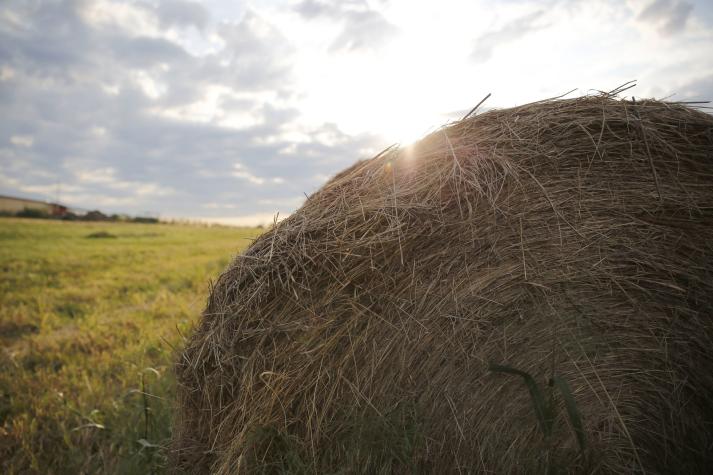'Your hay bales might be shedding weight faster than a steer on Ozempic.'
COLUMBIA, Mo. – Ask five farmers how much their hay bales weigh, and you’ll probably get five different answers — none of which are backed up by a scale ticket.
“That’s because most folks think they know their bale weights, but more often than not, they’re guessing,” says University of Missouri Extension state forage specialist and associate dean Rob Kallenbach. “And when you’re buying hay by the bale instead of by the ton, those guesses can cost you real money.”
Kallenbach says MU Extension specialists often ask people to estimate bale weights during events. “Time and time again, we see folks overestimate bale weights, sometimes by a couple hundred pounds,” he says. “That can lead to errors of 15% to 20%, which is a pretty steep tax if you’re buying. Worse yet, it can lead to thinking you’ve got enough hay for the winter when you really don’t.”
Many of those wrong guesses come from what Hamilton calls “neighbor talk.” If one neighbor says his bales are 1,100 pounds, the next one assumes theirs must be about the same. “That’s a risky way to do business,” says Hamilton.
Newer balers tend to pack hay tighter than the old ones, and other factors — baler settings, forage species, how dry it was when it got rolled up and storage conditions — can change the final weight. “The reality is your hay bales might be shedding weight faster than a steer on Ozempic,” says Kallenbach.
There’s only one surefire way to know what hay weighs. Put it on a scale. However, most buyers and sellers don’t have a scale big or handy enough to weigh bales. Plus, few sellers allow the buyer to weigh the hay before buying. “So, you have to make an educated guess,” says Hamilton.
Dennis Hancock, who directs the U.S. Dairy Forage Research Center in Madison, Wis., developed a method to give an idea of what bales weigh based on their size and how tightly they’re packed. “The tricky part is bale density — it varies a lot,” says Kallenbach. “For instance, a loosely packed 5-by-5 bale would have about 880 pounds of feed; a tightly packed one has nearly 1,200 pounds.” He gives a simple way to estimate bale density:
- Loose bales that depress and don’t spring back. Probably 9 pounds of dry matter (DM) per cubic foot or less.
- A little firmer but still gives when you press it. Around 10 lbs. DM per cubic foot.
- Good and solid, but you can still dent it with a spike. About 11 lbs. DM per cubic foot.
- You can barely get the hay spike in. Likely 12 lbs. DM per cubic foot or more.
To know how many cubic feet are in a round hay bale, you need to know its volume. That takes a bit of math. First, divide the diameter (or height) in feet of the bale by two. Square that number. Then multiply that by 3.14 and then multiply that result by the bale width in feet. The result is the volume of the bale in cubic feet.
For example, a 5-foot by 5-foot bale has 98 cubic feet of hay: (5/2)^2 x 3.14 x 5 = ~98. Loosely packed bales have a density of 9 pounds per cubic foot of hay, which equates to 880 pounds of dry feed. A tightly packed bale at 12 pounds/cubic foot would have almost 1,200 pounds of dry feed. Hancock’s figures are rough estimates, but they’re better than no estimate at all, says Hamilton.
“It’s easy to misjudge bale weights, and those mistakes add up,” says Kallenbach. “Whether you’re buying hay or figuring out how much you’ve got stored for winter, a little math and a little common sense can go a long way toward making sure you don’t come up short.”
For more information, see the MU Integrated Pest Management newsletter article.
| Table: Dry matter (DM) weight of common large round bale sizes at different densities | |||||
|---|---|---|---|---|---|
|
Bale Width |
Bale Height |
Bale Densities |
|||
|
9 |
10 |
11 |
12 |
||
|
ft |
lbs/ft³ (DM) |
||||
|
4.0 |
4.0 |
450 |
500 |
550 |
600 |
|
4.0 |
5.0 |
710 |
790 |
860 |
940 |
|
4.0 |
6.0 |
1,020 |
1,130 |
1,240 |
1,360 |
|
5.0 |
4.0 |
570 |
630 |
690 |
750 |
|
5.0 |
5.0 |
880 |
980 |
1,080 |
1,180 |
|
5.0 |
6.0 |
1,270 |
1,410 |
1,560 |
1,700 |
